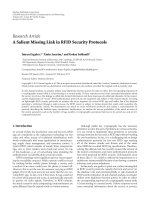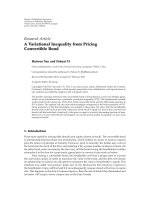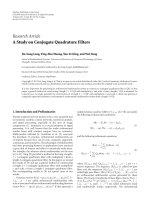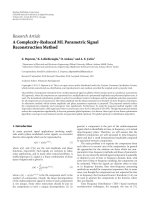Báo cáo hóa học: " Research Article A Recent Note on Quasi-Power Increasing Sequence for Generalized Absolute Summability" docx
Bạn đang xem bản rút gọn của tài liệu. Xem và tải ngay bản đầy đủ của tài liệu tại đây (488.44 KB, 10 trang )
Hindawi Publishing Corporation
Journal of Inequalities and Applications
Volume 2009, Article ID 675403, 10 pages
doi:10.1155/2009/675403
Research Article
A Recent Note on Quasi-Power Increasing
Sequence for Generalized Absolute Summability
E. Savas¸
1
and H. S¸evli
2
1
Department of Mathematics,
˙
Istanbul Ticaret University,
¨
Usk
¨
udar, 34672-
˙
Istanbul, Turkey
2
Department of Mathematics, Faculty of Arts & Sciences, Y
¨
uz
¨
unc
¨
uYıl University, 65080-Van, Turkey
Correspondence should be addressed to E. Savas¸,
Received 15 May 2009; Accepted 30 July 2009
Recommended by Ramm Mohapatra
We prove two theorems on |A, δ|
k
, k ≥ 1, 0 ≤ δ<1/k, summability factors for an infinite
series by using quasi-power increasing sequences. We obtain sufficient conditions for
a
n
λ
n
to
be summable |A, δ|
k
, k ≥ 1, 0 ≤ δ<1/k, by using quasi-f -increasing sequences.
Copyright q 2009 E. Savas¸andH.S¸evli. This is an open access article distributed under the
Creative Commons Attribution License, which permits unrestricted use, distribution, and
reproduction in any medium, provided the original work is properly cited.
1. Introduction
Quite recently, Savas¸ 1 obtained sufficient conditions for
a
n
λ
n
to be summable |A, δ|
k
,
k ≥ 1, 0 ≤ δ<1/k. The purpose of this paper is to obtain the corresponding result for quasi-
f-increasing sequence. Our result includes and moderates the conditions of his theorem with
the special case μ 0.
A sequence {λ
n
} is said to be of bounded variation bv if
n
|Δλ
n
| < ∞. Let bv
0
bv ∩ c
0
, where c
0
denotes the set of all null sequences.
The concept of absolute summability of order k ≥ 1 was defined by Flett 2 as follows.
Let
a
n
denote a series with partial sums {s
n
}, and A a lower triangular matrix. Then
a
n
is
said to be absolutely A-summable of order k ≥ 1, written that
a
n
is summable |A|
k
,k ≥ 1, if
∞
n1
n
k−1
|
T
n−1
− T
n
|
k
< ∞,
1.1
where
T
n
n
v0
a
nv
s
v
.
1.2
2 Journal of Inequalities and Applications
In 3, Flett considered further extension of absolute summability in which he
introduced a further parameter δ. The series
a
n
is said to be summable |A, δ|
k
, k ≥ 1, δ ≥ 0,
if
∞
n1
n
δkk−1
|
T
n−1
− T
n
|
k
< ∞.
1.3
A positive sequence {b
n
} is said to be an almost increasing sequence if there exist an
increasing sequence {c
n
} and positive constants A and B such that Ac
n
≤ b
n
≤ Bc
n
see 4.
Obviously, every increasing sequence is almost increasing. However, the converse need not
be true as can be seen by taking the example, say b
n
e
−1
n
n.
A positive sequence γ : {γ
n
} is said to be a quasi-β-power increasing sequence if there
exists a constant K Kβ, γ ≥ 1 such that
Kn
β
γ
n
≥ m
β
γ
m
1.4
holds f or all n ≥ m ≥ 1. It should be noted that every almost increasing sequence is a quasi-β-
power increasing sequence for any nonnegative β, but the converse need not be true as can be
seen by taking an example, say γ
n
n
−β
for β>0 see 5.If1.4 stays with β 0, then γ is
simply called a quasi-increasing sequence. It is clear that if {γ
n
} is quasi-β-power increasing,
then {n
β
γ
n
} is quasi-increasing.
A positive sequence γ {γ
n
} is said to be a quasi-f-power increasing sequence, if there
exists a constant K Kγ,f ≥ 1 such that Kf
n
γ
n
≥ f
m
γ
m
holds for all n ≥ m ≥ 1, 6.
We may associate A two lower triangular matrices
A and
A as follows:
a
nv
n
rv
a
nr
,n,v 0, 1, ,
a
nv
a
nv
− a
n−1,v
,n 1, 2, ,
1.5
where
a
00
a
00
a
00
. 1.6
Given any sequence {x
n
}, the notation x
n
O1 means x
n
O1 and 1/x
n
O1.
For any matrix entry a
nv
, Δ
v
a
nv
: a
nv
− a
n,v1
.
Quite recently, Savas¸ 1 obtained sufficient conditions for
a
n
λ
n
to be summable
|A, δ|
k
, k ≥ 1, 0 ≤ δ<1/k as follows.
Journal of Inequalities and Applications 3
Theorem 1.1. Let A be a lower triangular matrix with nonnegative entries satisfying
a
n−1,v
≥ a
nv
for n ≥ v 1, 1.7
a
n0
1,n 0, 1, , 1.8
na
nn
O
1
,n−→ ∞ , 1.9
n−1
v1
a
vv
a
n,v1
O
a
nn
, 1.10
m1
nv1
n
δk
|
Δ
v
a
nv
|
O
v
δk
a
vv
, 1.11
m1
nv1
n
δk
a
n,v1
O
v
δk
,
1.12
and let {β
n
} and {λ
n
} be sequences such that
|
Δλ
n
|
≤ β
n
, 1.13
β
n
−→ 0,n−→ ∞ . 1.14
If {X
n
} is a quasi-β-power increasing sequence for some 0 <β<1 such that
|
λ
n
|
X
n
O
1
,n−→ ∞ , 1.15
∞
n1
nX
n
Δβ
n
< ∞, 1.16
m
n1
n
δk−1
|
s
n
|
k
O
X
m
,m−→ ∞ ,
1.17
then the series
a
n
λ
n
is summable |A, δ|
k
, k ≥ 1, 0 ≤ δ<1/k.
Theorem 1.1 enhanced a theorem of Savas 7 by replacing an almost increasing
sequence with a quasi-β-power increasing sequence for some 0 <β<1. It should be
noted that if {X
n
} is an almost increasing sequence, then 1.15 implies that the sequence
{λ
n
} is bounded. However, when {X
n
} is a quasi-β-power increasing sequence or a quasi-f-
increasing sequence, 1.15 does not imply |λ
m
| O1,m →∞. For example, since X
m
m
−β
is a quasi-β-power increasing sequence for 0 <β<1 and if we take λ
m
m
δ
, 0 <δ<β<1,
then |λ
m
|X
m
m
δ−β
O1,m →∞holds but |λ
m
| m
δ
/
O1see 8. Therefore, we
remark that condition {λ
n
}∈bv
0
should be added to the statement of Theorem 1.1.
The goal of this paper is to prove the following theorem by using quasi-f-increasing
sequences. Our main result includes the moderated version of Theorem 1.1. We will show
that the crucial condition of our proof, {λ
n
}∈bv
0
, can be deduced from another condition
of the theorem. Also, we shall eliminate condition 1.15 in our theorem; however we shall
deduce this condition from the conditions of our theorem.
4 Journal of Inequalities and Applications
2. The Main Results
We now shall prove the following theorems.
Theorem 2.1. Let A satisfy conditions 1.7–1.12, and let {β
n
} and {λ
n
} be sequences satisfying
conditions 1.13 and 1.14 of Theorem 1.1 and
m
n1
λ
n
o
m
,m−→ ∞ .
2.1
If {X
n
} is a quasi-f-increasing sequence and conditions 1.17 and
∞
n1
nX
n
β, μ
Δβ
n
< ∞
2.2
are satisfied, then the series
a
n
λ
n
is summable |A, δ|
k
,k ≥ 1, 0 ≤ δ<1/k, where {f
n
} :
{n
β
log n
μ
},μ≥ 0, 0 ≤ β<1, and X
n
β, μ :n
β
log n
μ
X
n
.
Theorem 2.1 includes the following theorem with the special case μ 0. Theorem 2.2
moderates the hypotheses of Theorem 1.1.
Theorem 2.2. Let A satisfy conditions 1.7–1.12, and let {β
n
} and {λ
n
} be sequences satisfying
conditions 1.13, 1.14, and 2.1.If{X
n
} is a quasi-β-power increasing sequence for some 0 ≤ β<1
and conditions 1.17 and
∞
n1
nX
n
β
Δβ
n
< ∞
2.3
are satisfied, where X
n
β :n
β
X
n
, then the series
a
n
λ
n
is summable |A, δ|
k
,k ≥ 1, 0 ≤ δ<1/k.
Remark 2.3. The crucial condition, {λ
n
}∈bv
0
, and condition 1.15 do not appear among the
conditions of Theorems 2.1 and 2.2.ByLemma 3.3, under the conditions on {X
n
}, {β
n
}, and
{λ
n
} as taken in the statement of Theorem 2.1, also in the statement of Theorem 2.2 with the
special case μ 0, conditions {λ
n
}∈bv
0
and 1.15 hold.
3. Lemmas
We shall need the following lemmas for the proof of our main Theorem 2.1.
Lemma 3.1 see 9. Let {ϕ
n
} be a sequence of real numbers and denote
Φ
n
:
n
k1
ϕ
k
, Ψ
n
:
∞
kn
Δϕ
k
.
3.1
Journal of Inequalities and Applications 5
If Φ
n
on, then there exists a natural number N such that
ϕ
n
≤ 2Ψ
n
3.2
for all n ≥ N.
Lemma 3.2 see 8. If {X
n
} is a quasi-f-increasing sequence, where {f
n
} {n
β
log n
μ
},μ ≥
0, 0 ≤ β<1, then conditions 2.1 of Theorem 2.1,
m
n1
|
Δλ
n
|
o
m
,m−→ ∞ ,
3.3
∞
n1
nX
n
β, μ
|
Δ
|
Δλ
n
||
< ∞,
3.4
where X
n
β, μn
β
log n
μ
X
n
, imply conditions 1.15 and
λ
n
−→ 0,n−→ ∞ . 3.5
Lemma 3.3. If {X
n
} is a quasi-f-increasing sequence, where {f
n
} {n
β
log n
μ
},μ≥ 0, 0 ≤ β<1,
then, under conditions 1.13, 1.14, 2.1, and 2.2, conditions 1.15 and 3.5 are satisfied.
Proof. It is clear that 1.13 and 1.14⇒3.3.Also,1.13 and 2.2⇒3.4.ByLemma 3.2,
under conditions 1.13-1.14 and 2.1–2.2, we have 1.15 and 3.5.
Lemma 3.4. Let {X
n
} be a quasi-f-increasing sequence, where {f
n
} {n
β
log n
μ
},μ ≥ 0, 0 ≤ β<
1. If conditions 1.13, 1.14, and 2.2 are satisfied, then
nβ
n
X
n
O
1
, 3.6
∞
n1
β
n
X
n
< ∞.
3.7
Proof. It is clear that if {X
n
} is quasi-f-increasing, then {n
β
log n
μ
X
n
} is quasi-increasing.
Since β
n
→ 0,n →∞, from the fact that {n
1−β
log n
−μ
} is increasing and 2.2, we have
nβ
n
X
n
nX
n
∞
kn
Δβ
k
O
1
n
1−β
log n
−μ
∞
kn
k
β
log k
μ
X
k
Δβ
k
O
1
∞
kn
kX
k
Δβ
k
O
1
.
3.8
6 Journal of Inequalities and Applications
Again using 2.2,
∞
n1
β
n
X
n
O
1
∞
n1
X
n
∞
kn
Δβ
k
O
1
∞
k1
Δβ
k
k
n1
n
β
log n
μ
X
n
n
−β
log n
−μ
O
1
∞
k1
k
β
log k
μ
X
k
Δβ
k
k
n1
n
−β
log n
−μ
O
1
∞
k1
kX
k
β, μ
Δβ
k
O
1
.
3.9
4. Proof of Theorem 2.1
Let y
n
denote the nth term of the A-transform of the series
a
n
λ
n
. Then, by definition, we
have
y
n
n
i0
a
ni
s
i
n
v0
a
nv
λ
v
a
v
.
4.1
Then, for n ≥ 1, we have
Y
n
: y
n
− y
n−1
n
v0
a
nv
λ
v
a
v
.
4.2
Applying Abel’s transformation, we may write
Y
n
n−1
v1
Δ
v
a
nv
λ
v
v
r1
a
r
a
nn
λ
n
n
v1
a
v
.
4.3
Since
Δ
v
a
nv
λ
v
λ
v
Δ
v
a
nv
Δλ
v
a
n,v1
, 4.4
we have
Y
n
a
nn
λ
n
s
n
n−1
v1
Δ
v
a
nv
λ
v
s
v
n−1
v1
a
n,v1
Δλ
v
s
v
Y
n,1
Y
n,2
Y
n,3
, say.
4.5
Journal of Inequalities and Applications 7
Since
|
Y
n,1
Y
n,2
Y
n,3
|
k
≤ 3
k
|
Y
n,1
|
k
|
Y
n,2
|
k
|
Y
n,3
|
k
, 4.6
to complete the proof, it is sufficient to show that
∞
n1
n
δkk−1
|
Y
n,r
|
k
< ∞, for r 1, 2, 3.
4.7
Since {λ
n
} is bounded by Lemma 3.3,using1.9, we have
I
1
m
n1
n
δkk−1
|
Y
n,1
|
k
m
n1
n
δkk−1
|
a
nn
λ
n
s
n
|
k
≤
m
n1
n
δk
na
nn
k−1
a
nn
|
λ
n
|
k−1
|
λ
n
||
s
n
|
k
O
1
m
n1
n
δk
a
nn
|
λ
n
||
s
n
|
k
.
4.8
Using properties 1.15,inviewofLemma 3.3,and3.7,from1.9, 1.13,and1.17,
I
1
O
1
m−1
n1
|
Δλ
n
|
n
v1
v
δk
a
vv
|
s
v
|
k
O
1
|
λ
m
|
m
v1
v
δk
a
vv
|
s
v
|
k
O
1
m−1
n1
|
Δλ
n
|
n
v1
v
δk−1
|
s
v
|
k
O
1
|
λ
m
|
m
v1
v
δk−1
|
s
v
|
k
O
1
m−1
n1
β
n
X
n
O
1
|
λ
m
|
X
m
O
1
as m −→ ∞ .
4.9
Applying H
¨
older’s inequality,
I
2
m1
n2
n
δkk−1
|
Y
n,2
|
k
O
1
m1
n2
n
δkk−1
n−1
v1
|
Δ
v
a
nv
||
λ
v
||
s
v
|
k
O
1
m1
n2
n
δkk−1
n−1
v1
|
Δ
v
a
nv
||
λ
v
|
k
|
s
v
|
k
n−1
v1
|
Δ
v
a
nv
|
k−1
.
4.10
8 Journal of Inequalities and Applications
Using 1.9 and 1.11 and boundedness of {λ
n
},
I
2
O
1
m1
n2
n
δk
na
nn
k−1
n−1
v1
|
Δ
v
a
nv
||
s
v
|
k
|
λ
v
|
k−1
|
λ
v
|
O
1
m
v1
|
λ
v
||
s
v
|
k
m1
nv1
n
δk
|
Δ
v
a
nv
|
O
1
m
v1
v
δk
a
vv
|
λ
v
||
s
v
|
k
O
1
, as m −→ ∞ ,
4.11
as in the proof of I
1
.
Finally, again using H
¨
older’s inequality, from 1.9, 1.10,and1.12,
I
3
m1
n2
n
δkk−1
|
Y
n,3
|
k
O
1
m1
n2
n
δkk−1
n−1
v1
a
n,v1
|
Δλ
v
||
s
v
|
k
O
1
m1
n2
n
δkk−1
n−1
v1
a
n,v1
|
Δλ
v
|
k
|
s
v
|
k
a
1−k
vv
n−1
v1
a
vv
a
n,v1
k−1
O
1
m1
n2
n
δk
n−1
v1
a
n,v1
|
Δλ
v
|
k
|
s
v
|
k
a
1−k
vv
O
1
m
v1
|
Δλ
v
|
k
|
s
v
|
k
a
1−k
vv
m1
nv1
n
δk
a
n,v1
O
1
m
v1
v
|
Δλ
v
|
k
v
δk
a
vv
|
s
v
|
k
.
4.12
By Lemma 3.1, condition 3.3,inviewofLemma 3.3, implies that
n
|
Δλ
n
|
≤ 2n
∞
kn
|
Δ
|
Δλ
k
||
≤ 2
∞
kn
k
|
Δ
|
Δλ
k
||
4.13
holds. Thus, by Lemma 3.3, 3.4 implies that {n|Δλ
n
|} is bounded. Therefore, from 1.9 and
1.13,
I
3
O
1
m
v1
v
|
Δλ
v
|
k−1
v
|
Δλ
v
|
v
δk
a
vv
|
s
v
|
k
O
1
m
v1
vβ
v
v
δk−1
|
s
v
|
k
.
4.14
Journal of Inequalities and Applications 9
Using Abel transformation and 1.17,
I
3
O
1
m−1
v1
Δ
vβ
v
v
r1
r
δk−1
|
s
r
|
k
O
1
mβ
m
m
v1
v
δk−1
|
s
v
|
k
O
1
m−1
v1
Δ
vβ
v
X
v
O
1
mβ
m
X
m
.
4.15
Since
Δ
vβ
v
vβ
v
−
v 1
β
v1
vΔβ
v
− β
v1
, 4.16
we have
I
3
O
1
m−1
v1
vX
v
Δβ
v
O
1
m−1
v1
X
v1
β
v1
O
1
mX
m
β
m
O
1
, as m −→ ∞ ,
4.17
by virtue of 2.2 and properties 3.6 and 3.7 of Lemma 3.4.
So we obtain 4.7. This completes the proof.
5. Corollaries and Applications to Weighted Means
Setting δ 0 in Theorems 2.1 and 2.2 yields the following two corollaries, respectively.
Corollary 5.1. Let A satisfy conditions 1.7–1.10, and let {β
n
} and {λ
n
} be sequences satisfying
conditions 1.13, 1.14, and 2.1.If{X
n
} is a quasi-f-increasing sequence, where {f
n
} :
{n
β
log n
μ
},μ≥ 0, 0 ≤ β<1, and conditions 2.2 and
m
n1
1
n
|
s
n
|
k
O
X
m
,m−→ ∞ ,
5.1
are satisfied, then the series
a
n
λ
n
is summable |A|
k
,k ≥ 1.
Proof. If we take δ 0inTheorem 2.1, then condition 1.17 reduces condition 5.1 .Inthis
case conditions 1.11 and 1.12 are obtained by conditions 1.7–1.10.
Corollary 5.2. Let A satisfy conditions 1.7–1.10, and let {β
n
} and {λ
n
} be sequences satisfying
conditions 1.13, 1.14, and 2.1.If{X
n
} is a quasi-β-power increasing sequence for some 0 ≤ β<1
and conditions 2.3 and 5.1 are satisfied, then the series
a
n
λ
n
is summable |A|
k
,k ≥ 1.
A weighted mean matrix, denoted by
N,p
n
, is a lower triangular matrix with entries
a
nv
p
v
/P
n
, where {p
n
} is nonnegative sequence with p
0
> 0andP
n
:
n
v0
p
v
→∞, as
n →∞.
10 Journal of Inequalities and Applications
Corollary 5.3. Let {p
n
} be a positive sequence satisfying
np
n
O
P
n
, as n −→ ∞ , 5.2
m1
nv1
n
δk
p
n
P
n
P
n−1
O
v
δk
P
v
,
5.3
and let {β
n
} and {λ
n
} be sequences satisfying conditions 1.13, 1.14, and 2.1.If{X
n
} is a quasi-
f-increasing sequence, where {f
n
} : {n
β
log n
μ
},μ≥ 0, 0 ≤ β<1, and conditions 1.17 and 2.2
are satisfied, then the series,
a
n
λ
n
is summable |N,p
n
,δ|
k
for k ≥ 1 and 0 ≤ δ<1/k.
Proof. In Theorem 2.1 set A N,p
n
. It is clear that conditions 1.7, 1.8,and1.10 are
automatically satisfied. Condition 1.9 becomes condition 5.2, and conditions 1.11 and
1.12 become condition 5.3 for weighted mean method.
Corollary 5.3 includes the following result with the special case μ 0.
Corollary 5.4. Let {p
n
} be a positive sequence satisfying 5.2 and 5.3, and let {X
n
} be a quasi-β-
power increasing sequence for some 0 ≤ β<1. Then under conditions 1.13, 1.14, 1.17, 2.1,
and 2.3,
a
n
λ
n
is summable |N,p
n
,δ|
k
, k ≥ 1, 0 ≤ δ<1/k.
References
1 E. Savas¸, “Quasi-power increasing sequence for generalized absolute summability,” Nonlinear Analysis:
Theory, Methods & Applications, vol. 68, no. 1, pp. 170–176, 2008.
2 T. M. Flett, “On an extension of absolute summability and some theorems of Littlewood and Paley,”
Proceedings of the London Mathematical Society, vol. 7, pp. 113–141, 1957.
3 T. M. Flett, “Some more theorems concerning the absolute summability of Fourier series and power
series,” Proceedings of the London Mathematical Society, vol. 8, pp. 357–387, 1958.
4 S. Alijancic and D. Arendelovic, “O-regularly varying functions,” Publications de l’Institut Math
´
ematique,
vol. 22, no. 36, pp. 5–22, 1977.
5 L. Leindler, “A new application of quasi power increasing sequences,” Publicationes Mathematicae
Debrecen, vol. 58, no. 4, pp. 791–796, 2001.
6 W. T. Sulaiman, “Extension on absolute summability factors of infinite series,” Journal of Mathematical
Analysis and Applications, vol. 322, no. 2, pp. 1224–1230, 2006.
7 E. Savas¸, “On almost increasing sequences for generalized absolute summability,” Mathematical
Inequalities & Applications, vol. 9, no. 4, pp. 717–723, 2006.
8 H. S¸evli and L. Leindler, “On the absolute summability factors of infinite series involving quasi-power-
increasing sequences,” Computers & Mathematics with Applications, vol. 57, no. 5, pp. 702–709, 2009.
9 L. Leindler, “A note on the absolute Riesz summability factors,” Journal of Inequalities in Pure and Applied
Mathematics, vol. 6, no. 4, article 96, 5 pages, 2005.









